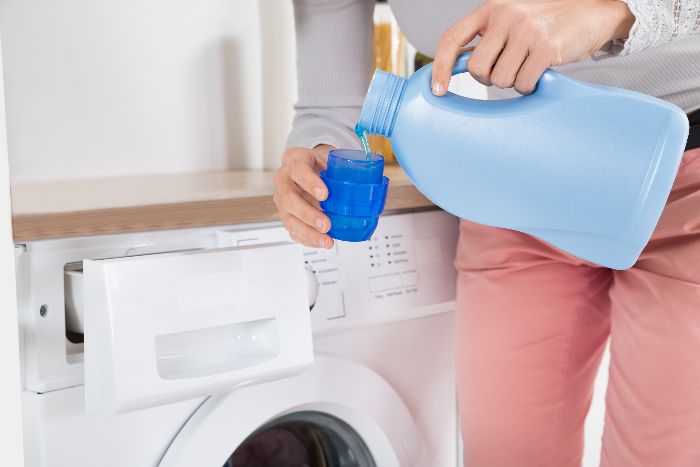Homemade Laundry Detergent – upto 600 Loads at Under $10

Make sure to like Living Green and Frugally on Facebook, Shop at Amazon to help support my site and explore our PINTEREST BOARDS for innovative ways you can become self-sufficient.
In the quest for a cost-effective and eco-friendly alternative to commercial laundry detergents, many have turned to DIY solutions that not only save money but also reduce exposure to harsh chemicals. One such economical and simple option is creating your homemade laundry detergent, providing a significant quantity of cleaning power for a fraction of the cost. With just a few basic ingredients, you can concoct a potent cleanser that can handle up to an impressive 600 loads, all for less than $10.
The Recipe:
Ingredients:
- 1 bar of soap (Fels-Naptha, Castile, or any preferred soap)
- 1 cup of washing soda
- 1 cup of borax
- Water
- Essential oils (optional, for fragrance)
Tools:
- Cheese grater or food processor
- Large pot or bucket
- Mixing spoon or whisk
- Empty containers for storage (such as old detergent bottles or jars)

Step-by-Step Instructions:
1. Grate the Soap:
- Begin by grating the entire bar of soap using a cheese grater or food processor. This step helps the soap dissolve more easily when mixed with water.
2. Mix the Ingredients:
- In a large pot or bucket, combine the grated soap, washing soda, and borax. Stir the ingredients together thoroughly to ensure an even distribution.
3. Add Water and Heat:
- Fill the pot or bucket with approximately 4-5 cups of hot water. Place it on the stove and heat the mixture, stirring continuously until all the ingredients dissolve completely. Ensure it doesn’t boil over.
4. Add More Water:
- Once the ingredients have dissolved, add enough hot water to fill the container, making a total of 2 gallons. Stir well to mix everything evenly.
5. Optional: Add Essential Oils (for Fragrance):
- If desired, incorporate a few drops of your preferred essential oils to impart a pleasant scent to the detergent. Lavender, lemon, or eucalyptus oils are popular choices.
6. Let it Cool and Set:
- Allow the mixture to cool and set for several hours or overnight. It may thicken as it cools, forming a gel-like consistency.
7. Transfer and Store:
- Once cooled and set, transfer the homemade laundry detergent into storage containers, such as old detergent bottles or jars, for easy dispensing.
Benefits of Homemade Laundry Detergent:
- Cost-Effective: The total cost of the ingredients required to make this detergent amounts to a fraction of what you’d spend on commercial detergents for the same quantity of loads.
- Environmentally Friendly: This DIY detergent contains fewer harsh chemicals, making it a greener alternative for both your clothes and the environment.
- Customizable: You can personalize the detergent by choosing your preferred soap or adding essential oils for a signature scent.

How to Use Homemade Laundry Detergent:
1. Load Size and Detergent Amount:
- Determine the appropriate amount of detergent based on your laundry load size. For a standard-sized load, approximately 1/4 to 1/2 cup of homemade detergent is typically sufficient. Adjust the amount based on the load size and soil level.
2. Dispensing:
- Pour the recommended amount of homemade detergent directly into the detergent dispenser or drum of your washing machine before adding the clothes.
3. Water Temperature:
- This homemade detergent can be used with various water temperatures, including cold, warm, or hot, depending on your laundry needs. Follow the garment care labels for water temperature recommendations.
4. Laundry Type:
- Suitable for both regular and high-efficiency (HE) washing machines. The detergent’s low-sudsing formula makes it compatible with HE machines.
5. Additional Tips:
- For heavily soiled clothing or larger loads, you might need to adjust the detergent amount accordingly.
- Store the remaining homemade detergent in a sealed container for future use.
6. Stain Treatment:
- For tough stains, consider pre-treating them with a stain remover or applying a paste made from the homemade detergent directly onto the stain before washing.
Benefits of Using Homemade Detergent:
- Effective Cleaning: Despite being homemade, this detergent is powerful and effectively cleans clothes, removing dirt, stains, and odors.
- Versatility: It can be used for various types of fabrics, including cotton, synthetics, and delicate materials, without causing damage.
- Economical: Using the appropriate amount per load helps maintain its cost-effectiveness, providing savings over commercial detergents.
Final Note:
Homemade laundry detergent offers a budget-friendly and environmentally conscious approach to cleaning clothes. By using this DIY solution in your washing machine, you not only achieve clean and fresh-smelling laundry but also contribute to reducing your environmental footprint and saving money in the long run. Adjust the amount used per load based on your specific laundry needs, and enjoy the benefits of a cost-effective and efficient homemade detergent.